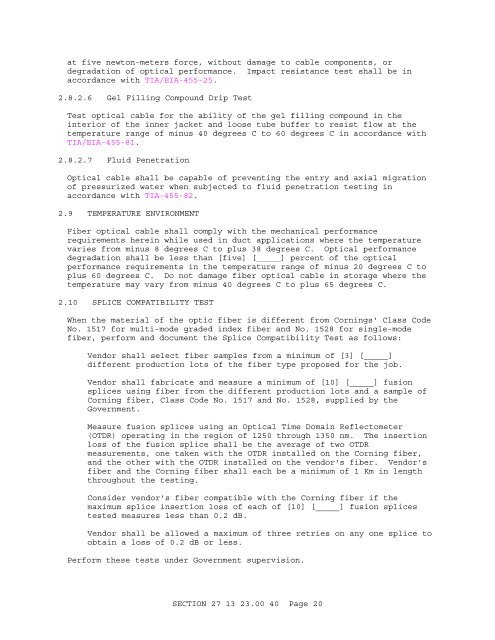UFGS 27 13 23.00 40 Communications Optical Backbone Cabling
UFGS 27 13 23.00 40 Communications Optical Backbone Cabling
UFGS 27 13 23.00 40 Communications Optical Backbone Cabling
You also want an ePaper? Increase the reach of your titles
YUMPU automatically turns print PDFs into web optimized ePapers that Google loves.
at five newton-meters force, without damage to cable components, ordegradation of optical performance. Impact resistance test shall be inaccordance with TIA/EIA-455-25.2.8.2.6 Gel Filling Compound Drip TestTest optical cable for the ability of the gel filling compound in theinterior of the inner jacket and loose tube buffer to resist flow at thetemperature range of minus <strong>40</strong> degrees C to 60 degrees C in accordance withTIA/EIA-455-81.2.8.2.7 Fluid Penetration<strong>Optical</strong> cable shall be capable of preventing the entry and axial migrationof pressurized water when subjected to fluid penetration testing inaccordance with TIA-455-82.2.9 TEMPERATURE ENVIRONMENTFiber optical cable shall comply with the mechanical performancerequirements herein while used in duct applications where the temperaturevaries from minus 8 degrees C to plus 38 degrees C. <strong>Optical</strong> performancedegradation shall be less than [five] [_____] percent of the opticalperformance requirements in the temperature range of minus 20 degrees C toplus 60 degrees C. Do not damage fiber optical cable in storage where thetemperature may vary from minus <strong>40</strong> degrees C to plus 65 degrees C.2.10 SPLICE COMPATIBILITY TESTWhen the material of the optic fiber is different from Cornings' Class CodeNo. 1517 for multi-mode graded index fiber and No. 1528 for single-modefiber, perform and document the Splice Compatibility Test as follows:Vendor shall select fiber samples from a minimum of [3] [_____]different production lots of the fiber type proposed for the job.Vendor shall fabricate and measure a minimum of [10] [_____] fusionsplices using fiber from the different production lots and a sample ofCorning fiber, Class Code No. 1517 and No. 1528, supplied by theGovernment.Measure fusion splices using an <strong>Optical</strong> Time Domain Reflectometer(OTDR) operating in the region of 1250 through <strong>13</strong>50 nm. The insertionloss of the fusion splice shall be the average of two OTDRmeasurements, one taken with the OTDR installed on the Corning fiber,and the other with the OTDR installed on the vendor's fiber. Vendor'sfiber and the Corning fiber shall each be a minimum of 1 Km in lengththroughout the testing.Consider vendor's fiber compatible with the Corning fiber if themaximum splice insertion loss of each of [10] [_____] fusion splicestested measures less than 0.2 dB.Vendor shall be allowed a maximum of three retries on any one splice toobtain a loss of 0.2 dB or less.Perform these tests under Government supervision.SECTION <strong>27</strong> <strong>13</strong> <strong>23.00</strong> <strong>40</strong> Page 20
















